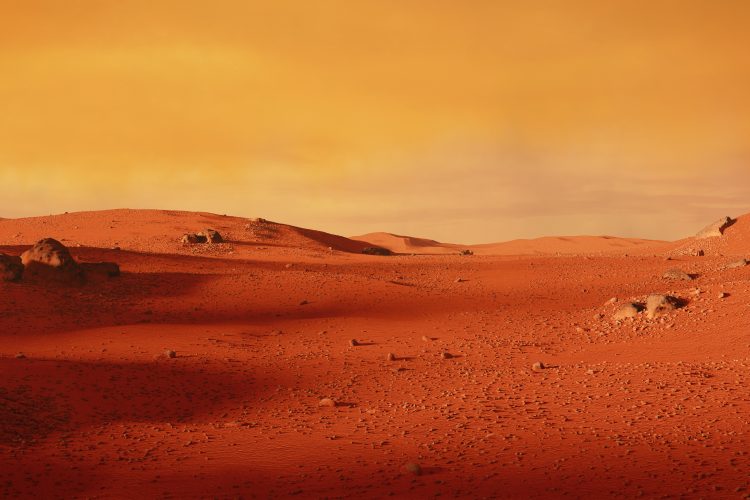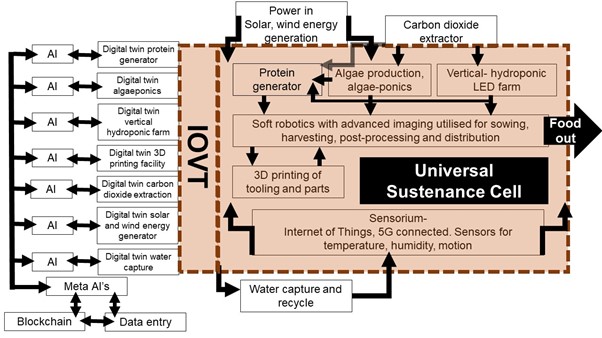Life on Mars: creating a Martian food system
- Like
- Digg
- Del
- Tumblr
- VKontakte
- Buffer
- Love This
- Odnoklassniki
- Meneame
- Blogger
- Amazon
- Yahoo Mail
- Gmail
- AOL
- Newsvine
- HackerNews
- Evernote
- MySpace
- Mail.ru
- Viadeo
- Line
- Comments
- Yummly
- SMS
- Viber
- Telegram
- Subscribe
- Skype
- Facebook Messenger
- Kakao
- LiveJournal
- Yammer
- Edgar
- Fintel
- Mix
- Instapaper
- Copy Link
Posted: 2 June 2021 | Dr Wayne Martindale, Professor Mark Swainson, Tom Æ Hollands | 2 comments
How would you go about building a food system on Mars? Three leading scientists look at the challenges presented by the Red Planet and explain why the exercise could be very relevant to Earth too.


Theorising what a food system might look like on the Red Planet could have uses on Earth too
Picture yourself looking out over a barren parched scrubland, littered with drying mud pools, tired sunken trees and withered vines – all baking in the hot sun. Only a generation earlier the scene was teaming with diverse wildlife, rolling fields of grains, grape vines and other crops; when it does rain, it is often in the extreme. Regional flooding can erode the topsoil vital to farming, and has the potential to transport sewage, manure and other pollutants from the roads onto these tortured lands and muddy drying water ways.1
Extreme droughts, invasive species, perpetual water shortages and groundwater depletion are all likely as a result of climate change. These consequences are already being faced by some major food producing regions, including the US corn belt, the California Central Valley, and vast regions in Pakistan, India, north-western China, Iran and Iraq.
Without extensive and costly intervention, such regions are likely to become increasingly hostile to food production and eventually degrade to become dust bowls; becoming remarkably similar to the conditions one would find on Mars, albeit much colder.2
A sprawling metropolis with a higher population than the entirety of Australia, New Delhi has a heavily subsidised food grain programme which aims to ensure specific foods are supplied every month to eligible household.3 The city is densely populated, availability of food refrigeration is estimated at only 30 percent per household, electricity supply is intermittent, and the high temperatures coupled with high relative humidity cause foods to spoil quickly.4
Pollutants, smog and zoonoses can be found in the land, water and air surrounding the city, and primary food production is stymied in the regional vicinity. The transport routes are over capacity, dangerous and fragile; any available space is at a premium and fresh food travels significant distances prior to consumption, often without the benefit of an integrated and consistent cool/chill chain.5
These megacity (a large city typically with a population of more than 10 million) environments and challenges are increasingly common. Such conditions manifest in most cities across the world to varying degrees, but climate change has the potential to intensify challenges around food security.
Food production, supply and storage is a significant contributor to greenhouse gas emissions. With climate change likely to hamper our capacity to produce enough food, this is a positive feedback loop of the most negative kind.
Moreover, a third of the global population are classed as obese6, yet inequality and malnutrition continues to sweep the world.7 Initiatives to rethink food systems often remain on the drawing board due to numerous socioeconomic and geopolitical factors.
The food system is not adapting fast enough to the global challenges we face. If the human species is to avoid over half of its global population suffering some form of malnutrition by 2030, urgent action needs to be taken to improve access to high-quality food.8
Inspiration is needed alongside global commitment to change. If we now act in a swift, coordinated and effective manner, then the impacts of climate change can be lessened and a more sustainable future secured.
Here we can look to Mars – with its harsh environment – for inspiration.
Building the foundations of a Martian food system
For food production systems to succeed on Mars, it will require multi-disciplinary science and effective application of outputs into an array of fused technologies to sustain human populations in hostile environments. In many cases such technological solutions will already be in commercial use for applications on Earth and so can be repurposed.
A great deal of innovation will be required and, critically, innovations will not only need to solve the challenge presented in a safe and consistent manner, but also in the most efficient way possible.9,10
These multifaceted challenges mean that technological solutions do not always have to be ‘high-tech’ – instead they must be multi-layered and appropriate, ie, not ‘over-tech’.
The universal sustenance cell
A blend of highly advanced science, technologies and biological systems will be required to produce food, sustainably and efficiently in hostile environments. Although a ‘has not yet been created, we can envisage that the following would serve as key aspects and components of such a multifaceted controlled environment food production system (see Figure 1).


Figure 1. A schematic of the USC
Biological aspects of a USC
Hydroponic systems could be a potential option for use within a USC. Hydroponic simply means feeding plants using water/mist, ie, plants draw their nutrition from the added feed and not soil. Hydroponic systems are typically characterised as either run ebb and flow systems or continuous flow systems. They can be very water efficient and yields are high. LED technology is readily used, but energy consumption can be high, and outbreaks of pests and diseases have the potential to be rapid if not proactively prevented or acted upon swiftly.
In addition, scientists may turn to algaeponic technologies. With more than 10 times the growth rate compared with terrestrial plants and requiring just a tenth of the landmass to produce equivalent biomass, algae are a sustainable crop source. Algae does not require clean water (and could be used in part to treat water) and being a robust organism would likely be well suited to growth in hostile environments. Algae is a high protein and lipid food source that will certainly have an increasing role in future food systems.
Finally, genetic modification (GM) could also be used to build a more reliable food supply. Changes could include increasing the nutritional value of a plant or making it more resistant to disease or herbicides. Modification could be for a wide range of properties, including disease and pest resistance, raised yields, improved nutritional content, pharma agents, fuel, natural packaging, ripeness, storage/transport resistance, reduction of enzymic browning, etc. The modification may involve one or multiple changes to the genome.
What technology would be needed to control a USC?
Artificial Intelligence (AI) is one technology which would no doubt prove invaluable. These are computer programs that mimic human intelligence, using logic, ‘if – then’, decision trees. Machine learning (ML) and deep thinking are subsets of AI and permit the AI to learn through the data. Being software applications, AI can run from mobile phone scale equipment, meaning of all the technological deployments required, AI is likely to be the most versatile.
Although AI deployments are in a very narrow bandwidth compared to human counterparts, they do vastly exceed human capacity for speed and accuracy. AI would therefore be utilised to identify and maintain (acting and adapting) resource deployments and environmental conditions (eg, seeds, water, energy, CO2, sunlight). Benefits could include identification of resource losses/waste and swift progress of corrective actions to avoid and solve conflicts, ensuring a responsive optimisation approach throughout the whole universal system.
The capability for artificial intelligence does not end there though, as soft robotics are also likely to be useful in a hostile environment. Mimicking the gentle touch and movement of human hands, an end effector (gripper) at the end of a robot arm can pick up and manipulate objects. In hostile environments robots will be easier to maintain compared to their human counterparts.
Being mobile, robots can be deployed for a whole host of tasks without requiring a break, food or water. Moreover, hygienic design and cleaning systems will ensure that the robot will not pose a microbiological safety risk to the foods they handle.
Combined with Machine Learning, the robotic systems will improve their efficiency and functionality over time and can share those learnings with other robotic applications, making further deployment easier and highly beneficial.
Using 3-D printing to produce tools, components or even food, could also be crucial. This technology removes the need to hold vast stores of spare parts, rather the primary material/reagent (such as plastic) is required, and from that an almost infinite array of objects can be made. This could help ensure that food production system downtime is mitigated and the time to obtain and use objects is reduced to demand.
Concluding thoughts
The future of farming and food production will rely on an array of technologies as we begin to see more hostile environments and this, in turn, will create new technologies and practices necessary to support colonisation on Mars.
A USC is likely to be one of the pre-requisites for humans to secure our future on Earth and at the same time enable us also to become a space faring species. This is no moon shot, it is an Earth shot with a Mars rebound!
References
- Carlson, K.M.; Gerber, J.S.; Mueller, N.D.; Herrero, M.; MacDonald, G.K.; Brauman, K.A.; Havlik, P.; O’Connell, C.S.; Johnson, J.A.; Saatchi, S. Greenhouse gas emissions intensity of global croplands. Nat. Clim. Chang. 2017, 7, 63.
- Ma, R.; Zhang, Z.; Tong, K.; Huber, D.; Kornbluh, R.; Ju, Y.S.; Pei, Q. Highly efficient electrocaloric cooling with electrostatic actuation. Science (80-. ). 2017, 357, 1130 LP – 1134.
- Kourtit, K.; Nijkamp, P.; Suzuki, S. Are global cities sustainability champions? A double delinking analysis of environmental performance of urban agglomerations. Sci. Total Environ. 2020, 709, 134963.
- Shaw, A. Towards sustainable cities in India. In Sustainable urbanization in India; Springer, 2018; pp. 23–37.
- Sala, S.; Anton, A.; McLaren, S.J.; Notarnicola, B.; Saouter, E.; Sonesson, U. In quest of reducing the environmental impacts of food production and consumption. J. Clean. Prod. 2017, 140
- Ritchie et al 2017
- UNICEF Global Nutrition Report 2020
- EURACTIV, UN Food and Agriculture Organisation (FAO) 2017
- Cannon, K.M.; Britt, D.T. Feeding one million people on Mars. New Sp. 2019, 7, 245–254.
- Nangle, S.N.; Wolfson, M.Y.; Hartsough, L.; Ma, N.J.; Mason, C.E.; Merighi, M.; Nathan, V.; Silver, P.A.; Simon, M.; Swett, J. The case for biotech on Mars. Biotechnol. 2020, 38, 401–407
About the authors
Tom Æ Hollands
Tom Æ Hollands is the Innovation and Technical Director at Raynor Foods, he is an accomplished food scientist who has worked in both government and the private sector. His innovations are focused around sustainability and has interests in meta food systems, their emerging technologies and the complex links that connect them.
Professor Mark Swainson
Professor Mark Swainson is Deputy Head of the National Centre for Food Manufacturing and lead for Higher Education and Research. His industrial food manufacturing sector expertise was developed whilst working in senior technical and operations management roles within the high risk chilled and frozen food industry for suppliers of a wide range of products to the major supermarkets, food manufacturing and food service sectors. Mark has progressed industry-based research and works with businesses on bespoke innovative projects in order to address specific food industry needs and issues.
Dr Wayne Martindale
Dr Wayne Martindale is Associate Professor in Food Insights and Sustainability at the National Centre for Food Manufacturing, University of Lincoln.
He leads the Food Insights and Sustainability Research agenda at NCFM, working with food and beverage manufacturers to deliver a carbon neutral or carbon zero food system. He is also a Fellow of the Institute of Food Science and Technology, a science champion for nutrition for the STFC Food+ Network which all support Early Career Researchers.
Related topics
Data & Automation, Environment, Processing, Research & development, Supply chain, Sustainability
Related organisations
National Centre for Food Manufacturing, Raynor Foods, University of Lincoln










This is really interesting – any more info on USC?
awesome